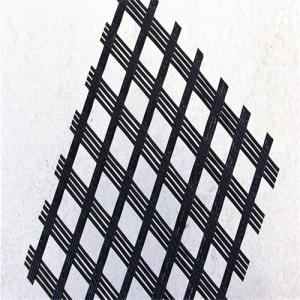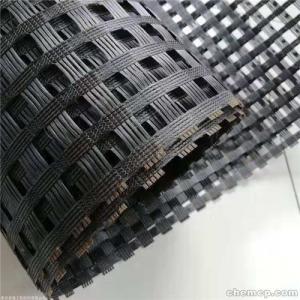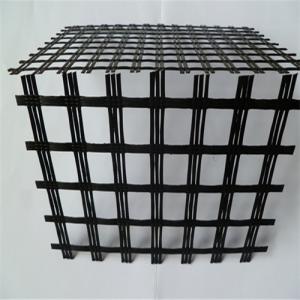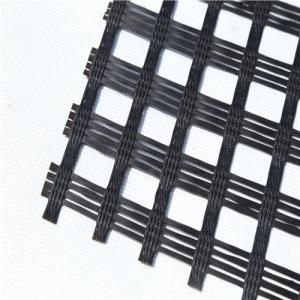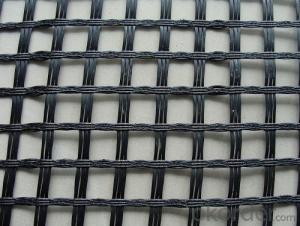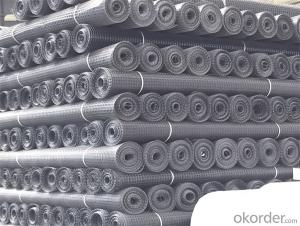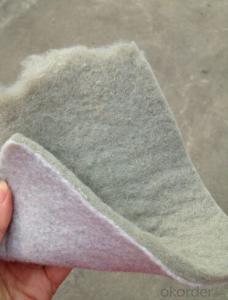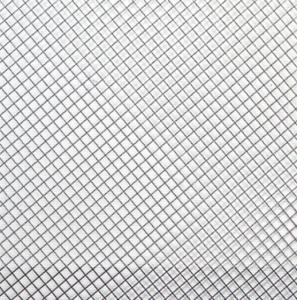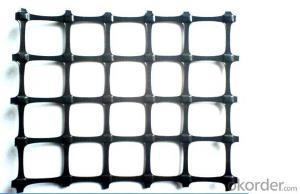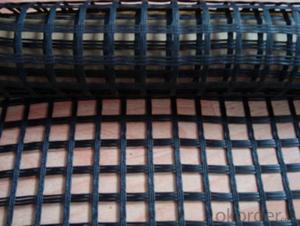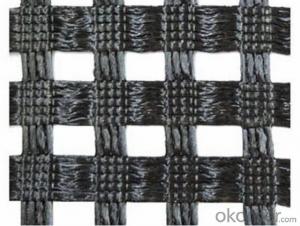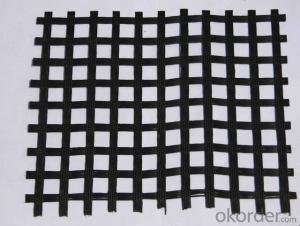Fiberglass Geogrids in Civil Engineering Construction
- Loading Port:
- China main port
- Payment Terms:
- TT or LC
- Min Order Qty:
- 1000 m²
- Supply Capability:
- 1000000 m²/month
OKorder Service Pledge
OKorder Financial Service
You Might Also Like
Fiberglass Geogrid Introduction
Geogrids form a distinct category of geosynthetics designed for reinforcement. These products are characterized by a relatively high tensile strength and a uniformly distributed array of large apertures (openings between the longitudinal and transverse elements). The apertures allow soil particles on either side of the installed sheet to come into direct contact, thereby increasing the interaction between the geogrid, aggregate and some soils. Also, the apertures ensure vertical drainage of a reinforced free-draining aggregate/soil.
The geogrid elements vary in polymer type and cross-sectional dimensions. They can sometimes change shape and dimensions within their length. Geogrids are either integrally manufactured (punched and drawn sheets; or extruded), ultrasonically or adhesive bonded strips, or joined in a knitting or weaving process and then coated. Polymer types include polyethylene, polypropylene or high tenacity polyester that has been coated.
Although geogrids are used primarily for reinforcement, some products are designed for asphalt overlay and waterproofing or for separation and stabilization. Geogrids also are used as gabions and sheet anchors, inserted between geotextiles and geomembranes, or used to construct mattresses for fills or embankments over soft soils.Woven Geogrids are flat structures in the shape of a net made of high module synthetic fibres, that may also be coated with a further protection layer, using synthetic material (usually PVC or other polymer).
Geogrid application filled with ground material is one of the easy of soil reinforcement. The thickness of such construction may be 50% less than the thickness of standard replacement which allows avoiding costly soil replacement.

Our Service
1.On a regular basis or as per your request,we entrust national testing agencies to conduct quality inspections
2. Strictly in accordance with the ISO9001-2008 international quality system standard,we monitor and manage the whole process throughout production,quality testing,and measurement to ensure product quality
3. For quality-related construction delay or substandard construction(except for damage or losses due to customer’s responsibility or irresistible natural disasters),we have refunding,replacement,and repair services.We will respond to customers’ feedbacks on quality issues within 24 hours.
After-sales service
1.In order to provide customers with comprehensive technical support,we will provide technical and other related information upon request in a timely manner.
2.In required,we will appoint specialized technicians to the construction site to give technical trainings to construction people,and offer technical guidance throughout the whole construction process.
3.For damage due to shipment and delivery,after we receive the complaint,we will check the issure through provided pictures and videos.If our responsibility is confirmed,we wil offer free replacement.
4.When the construction is completed,as your request,our technical staff may participate in the final acceptance.
FAQ:
Q: What kind of payments does jenor support?
A: T/T, L/C, Cash are accepted.
Q: Do you charge for the samples?
A: Accordeing to our company policy, the samples are free, we only charge the freight fee. And we will return the freight fee during the next order.
Q: Can you produce according to customers' design?
A: Sure, we are professional manufacturer, OEM and ODM are both welcome.

- Q:What are the criteria for the use of plastic geogrid
- Each grid has a variety of specifications, the specific reference to the national standard requirements, but the specifications are not necessarily the same as the national standard.
- Q:What are the advantages of using geogrids in ground improvement for load transfer platforms?
- Geogrids offer several advantages in ground improvement for load transfer platforms. Firstly, they provide reinforcement to the soil, increasing its bearing capacity and allowing it to support heavy loads. This helps to prevent settlement and stability issues that can arise from excessive loading. Secondly, geogrids distribute the load more evenly across the ground, reducing the stress concentration that can occur at specific points. This helps to minimize the risk of localized failures and ensures a more uniform transfer of loads. Additionally, geogrids improve the overall performance of the ground by increasing its stiffness and reducing deformations. This can be particularly beneficial in areas with weak or poorly compacted soils, as it enhances the stability and load-bearing capacity of the ground. Furthermore, geogrids are cost-effective compared to traditional methods of ground improvement, such as deep foundation systems. They require less material and labor, resulting in reduced construction costs and shorter project timelines. Overall, the advantages of using geogrids in ground improvement for load transfer platforms include increased bearing capacity, improved load distribution, enhanced ground performance, and cost savings.
- Q:Are geogrids suitable for erosion control?
- Yes, geogrids are suitable for erosion control. Geogrids are often used as a reinforcement material in soil stabilization and erosion control applications. These synthetic materials are designed to improve the stability and strength of the soil, preventing erosion and soil displacement. Geogrids can effectively distribute loads, reduce water flow velocity, and enhance the overall performance of erosion control measures.
- Q:Do geogrids provide reinforcement to geosynthetic clay liners in landfill caps?
- Yes, geogrids can provide reinforcement to geosynthetic clay liners in landfill caps. Geogrids are commonly used to enhance the stability and load-bearing capacity of geosynthetic clay liners by providing additional tensile strength and preventing lateral displacement of the clay liner. This reinforcement helps to improve the overall performance and longevity of landfill caps.
- Q:What are the factors that affect the installation time of geogrids?
- The factors that affect the installation time of geogrids include the size and complexity of the project, the type and condition of the soil, the equipment and manpower available, the weather conditions, and any potential obstacles or site constraints that may need to be addressed.
- Q:Can geogrids be used in coastal protection?
- Yes, geogrids can be used in coastal protection. Geogrids are commonly used in various coastal protection measures such as shoreline stabilization, erosion control, and sea defense structures. They provide reinforcement and stability to coastal soil and structures while allowing for proper drainage and vegetation growth. Geogrids help to prevent erosion and mitigate the impacts of waves, tides, and storm surges, making them an effective solution for coastal protection.
- Q:What are the differences between geogrids and geocomposites?
- Geogrids and geocomposites are both used in soil stabilization and reinforcement applications, but they have some key differences. Geogrids are typically made from high-strength polymers or fiberglass, and they have a grid-like structure with open spaces. They are designed to provide tensile strength and distribute loads across a wider area. Geogrids are mainly used for reinforcing soils, retaining walls, and roadways. On the other hand, geocomposites are multi-layered materials that combine different geosynthetic components. They usually consist of a geotextile fabric or membrane bonded to a geogrid or geonet layer. Geocomposites offer a combination of functions such as filtration, drainage, separation, and reinforcement. They are commonly used in applications like erosion control, landfill engineering, and drainage systems. In summary, while geogrids focus on reinforcement and load distribution, geocomposites offer a more versatile solution by combining multiple functions in a single product.
- Q:What is the distance between the waterproof plate and the top of the tunnel? What are the relevant provisions of this specification?
- The main production and operation of a variety of plastic geogrid, steel plastic composite geogrid, fiberglass geogrid, warp knitted polyester geogrid
- Q:What is the difference between woven and non-woven geogrids?
- Woven geogrids are made by weaving individual yarns together, creating a grid-like structure. Non-woven geogrids, on the other hand, are manufactured by bonding or interlocking fibers together through mechanical, thermal, or chemical processes. The key difference is in the manufacturing process, which results in woven geogrids being stronger and more rigid, while non-woven geogrids tend to be more flexible and have higher tensile strength. Additionally, woven geogrids are generally used in applications that require high load-bearing capacity, while non-woven geogrids are often used for soil stabilization and separation purposes.
- Q:Can geogrids be used in stabilization of river training structures?
- Yes, geogrids can be used in the stabilization of river training structures. Geogrids are commonly used in civil engineering projects to reinforce and stabilize soil and structures. In the case of river training structures, geogrids can be used to prevent erosion and provide stability to the riverbanks, retaining walls, and other structures. They can enhance the structural integrity and longevity of these structures, making them an effective solution for river stabilization.
1. Manufacturer Overview |
|
|---|---|
| Location | |
| Year Established | |
| Annual Output Value | |
| Main Markets | |
| Company Certifications | |
2. Manufacturer Certificates |
|
|---|---|
| a) Certification Name | |
| Range | |
| Reference | |
| Validity Period | |
3. Manufacturer Capability |
|
|---|---|
| a)Trade Capacity | |
| Nearest Port | |
| Export Percentage | |
| No.of Employees in Trade Department | |
| Language Spoken: | |
| b)Factory Information | |
| Factory Size: | |
| No. of Production Lines | |
| Contract Manufacturing | |
| Product Price Range | |
Send your message to us
Fiberglass Geogrids in Civil Engineering Construction
- Loading Port:
- China main port
- Payment Terms:
- TT or LC
- Min Order Qty:
- 1000 m²
- Supply Capability:
- 1000000 m²/month
OKorder Service Pledge
OKorder Financial Service
Similar products
New products
Hot products
Hot Searches
Related keywords
